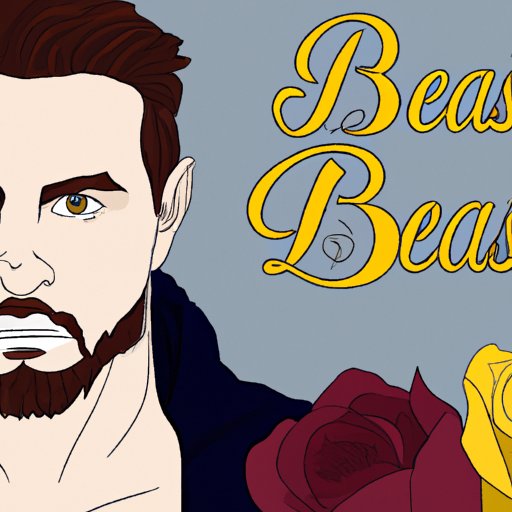
Introduction
Have you ever wondered who Gaston truly is in Beauty and the Beast? Sure, he’s the arrogant, muscle-bound villain who tries to win Belle’s heart through manipulation and force. But what else is there to know about him? Understanding Gaston’s character is important because it unlocks the deeper themes of toxic masculinity, societal beauty standards, and the blurred lines between heroism and villainy in Disney’s classic tale. Through an analysis of Gaston’s character, we can learn more about the complexity of the story and the social commentary that underlies it.
Breaking Down Gaston: A Look into the Iconic Villain of Beauty and the Beast
Gaston is a tall and muscular man with chiseled features, a cleft chin, and flowing chestnut hair. He is confident, competitive, and driven to succeed. However, he is also incredibly narcissistic, self-centered, and lacks empathy for anyone who fails to meet his expectations. Gaston’s motivation throughout much of the film is to win Belle’s heart, not because he loves her, but because she is considered the most beautiful woman in the village and therefore a desirable object to possess.
Interestingly, Gaston’s character serves as a foil to the Beast, who is initially portrayed as a monstrous and violent creature but who ultimately learns to love and be loved in return. Gaston, on the other hand, remains focused on his own desires, and his inability to empathize or understand others ultimately leads to his downfall.
The Evolution of Gaston: From Arrogant Hunter to Despicable Villain
Throughout the film, Gaston’s character evolves from an arrogant and pompous hunter to a despicable villain who stops at nothing to get what he wants. In the beginning, Gaston appears to be a harmless, albeit annoying, suitor to Belle. However, as the story unfolds, his true nature and motivations become increasingly clear.
Gaston’s actions become progressively more cruel and harmful to Belle, the Beast, and the other villagers. He manipulates Belle’s father into being sent to an insane asylum, rallies the townspeople to kill the Beast, and even attempts to murder the Beast himself. In the end, Gaston’s egotistical nature and obsession with winning Belle’s love ultimately lead to his defeat.
Beyond the Beast: Examining the Importance of Gaston in Disney’s Classic Tale
While Gaston is undoubtedly the film’s primary antagonist, his character adds depth and complexity to the story beyond just a typical villain. Through Gaston, the film explores themes of toxic masculinity and societal beauty standards. Gaston’s obsession with Belle is not just about her physical beauty, but also her status as the most desirable woman in the village. His desire to win her heart is driven by a need for power and prestige rather than genuine affection.
Furthermore, Gaston’s manipulation and abuse of Belle highlights the societal pressures placed on women to conform to beauty standards and marry for status. His character serves as a critique of the traditional gender roles and patriarchal norms that perpetuate these harmful expectations.
The Real Villain of Beauty and the Beast: Why Gaston is More Than Just a Bully
Some critics have argued that Gaston is just a one-dimensional bully character who is easy to dislike but not particularly interesting. However, upon closer examination, Gaston is much more complex than that. His manipulation, lies, and willingness to harm others make him a truly terrifying villain who is capable of inflicting significant harm on those around him.
Furthermore, Gaston’s character is significant because he represents a real-world type of toxic masculinity that is all too common. While his actions are extreme, the underlying attitudes and beliefs that motivate him are not unique. By casting Gaston as a villain, the film critiques and challenges the harmful effects of toxic masculinity on individuals and society as a whole.
Understanding Gaston: How the Film’s Controversial Character Became a Fan Favorite
Despite all of his villainous actions, Gaston has become a popular and beloved character in the Disney fandom. Part of the reason for this is his comedic moments and exaggerated personality, which provide a much-needed contrast to the serious themes of the film. Additionally, some fans appreciate Gaston’s infectious confidence and competitive spirit, even if they don’t agree with his actions.
However, it is worth noting that some fans have also criticized Gaston’s character as a glorification of toxic masculinity. While the film ultimately casts him as a villain and condemns his actions, some viewers may interpret him as a hero figure, which can be problematic.
Deconstructing Gaston: The Toxic Masculinity of Beauty and the Beast
One of the most significant ways that Gaston’s character contributes to the overall themes of the film is through his embodiment of toxic masculinity. Gaston’s hypermasculine and violent tendencies are presented as detrimental to himself and those around him. His relentless pursuit of power and status come at the expense of human connection and empathy.
By portraying Gaston as a toxic figure, the film critiques traditional gender roles and societal expectations. Through Belle and the Beast’s evolution throughout the story, the film shows that true love and connection require vulnerability, empathy, and emotional intelligence. These qualities are often dismissed as feminine or weak by toxic masculinity but are ultimately presented as the key to a fulfilling and meaningful life.
Conclusion
In conclusion, understanding Gaston’s character adds depth and complexity to the overall narrative of Beauty and the Beast. His narcissistic, violent, and manipulative nature embodies the harmful effects of toxic masculinity and the societal pressures placed on women to conform to beauty standards. While he may be easy to dislike, Gaston is not simply a one-dimensional bully but a complex figure who challenges our understanding of heroism and villainy. As we continue to watch and analyze Disney classics like Beauty and the Beast, it is essential to grapple with the deeper social and cultural issues that underlie these seemingly simple children’s stories.





